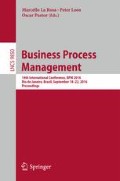Abstract
Many factors influence the creation of understandable business process models for an appropriate audience. Understandability of process models becomes critical particularly when a process is complex and its model is large in structure. Using modularization to represent such models hierarchically (e.g. using sub-processes) is considered to contribute to the understandability of these models. To investigate this assumption, we conducted an experiment that involved 2 large-scale real-life business process models that were modeled using BPMN v2.0 (Business Process Model and Notation). Each process was modeled in 3 modularity forms: fully-flattened, flattened where activities are clustered using BPMN groups, and modularized using separately viewed BPMN sub-processes. The objective is to investigate if and how different forms of modularity representation in BPMN collaboration diagrams influence the understandability of process models. In addition to the forms of modularity representation, we also looked into the presentation medium (paper vs. computer) as a factor that potentially influences model comprehension. Sixty business practitioners from a large organization participated in the experiment. The results of our experiment indicate that for business practitioners, to optimally understand a BPMN model in the form of a collaboration diagram, it is best to present the model in a ‘fully-flattened’ fashion (without using collapsed sub-processes in BPMN) in the ‘paper’ format.
Access this chapter
Tax calculation will be finalised at checkout
Purchases are for personal use only
References
Dumas, M., La Rosa, M., Mendling, J., Reijers, H.A.: Fundamentals of Business Process Management. Springer, Heidelberg (2013)
Reijers, H.A., Mendling, J.: A study into the factors that influence the understandability of business process models. IEEE Trans. Syst. Man Cybern. - Part A Syst. Hum. 41, 449–462 (2011)
Houy, C., Fettke, P., Loos, P.: On the theoretical foundations of research into the understandability of business process models. In: ECIS 2014, pp. 1–38 (2014)
Recker, J.: Empirical investigation of the usefulness of Gateway constructs in process models. Eur. J. Inf. Syst. 22, 673–689 (2012)
Sanchez-Gonzalez, L., Garcia, F., Ruiz, F., Mendling, J.: Quality indicators for business process models from a gateway complexity perspective. Inf. Softw. Technol. 54, 1159–1174 (2012)
Zugal, S., et al.: Investigating expressiveness and understandability of hierarchy in declarative business process models. Softw. Syst. Model. 14, 1081–1103 (2013)
Reijers, H.A., Mendling, J.: Modularity in process models: review and effects. In: Dumas, M., Reichert, M., Shan, M.-C. (eds.) BPM 2008. LNCS, vol. 5240, pp. 20–35. Springer, Heidelberg (2008)
Moody, D.L.: Cognitive load effects on end user understanding of conceptual models: an experimental analysis. In: Benczúr, A.A., Demetrovics, J., Gottlob, G. (eds.) ADBIS 2004. LNCS, vol. 3255, pp. 129–143. Springer, Heidelberg (2004)
Reijers, H.A., Mendling, J., Dijkman, R.M.: Human and automatic modularizations of process models to enhance their comprehension. Inf. Syst. 36, 881–897 (2011)
Figl, K., Koschmider, A., Kriglstein, S.: Visualising process model hierarchies. In: ECIS 2013, p. 180 (2013)
Leymann, F., Roller, D.: Workflow-based applications. IBM Syst. J. 36, 102–123 (1997)
van der Aalst, W., van Hee, K.: Workflow Management: Models, Methods, and Systems. MIT Press, Cambridge (2002)
Zugal, S., Pinggera, J., Weber, B., Mendling, J., Reijers, H.A.: Assessing the impact of hierarchy on model understandability – a cognitive perspective. In: Kienzle, J. (ed.) MODELS 2011 Workshops. LNCS, vol. 7167, pp. 123–133. Springer, Heidelberg (2012)
Houy, C., Fettke, P., Loos, P.: Understanding understandability of conceptual models – what are we actually talking about? In: Atzeni, P., Cheung, D., Ram, S. (eds.) ER 2012 Main Conference 2012. LNCS, vol. 7532, pp. 64–77. Springer, Heidelberg (2012)
Johannsen, F., Leist, S., Braunnagel, D.: Testing the impact of wand and weber’s decomposition model on process model understandability. In: ICIS 2014, pp. 1–13 (2014)
Wand, Y., Weber, R.: A model of systems decomposition. In: ICIS 1989 (1989)
Cruz-Lemus, J.A., Genero, M., Manso, M.E., Morasca, S., Piattini, M.: Assessing the understandability of UML statechart diagrams with composite states—A family of empirical studies. Empir. Softw. Eng. 14, 685–719 (2009)
Zugal, S., Soffer, P., Pinggera, J., Weber, B.: Expressiveness and understandability considerations of hierarchy in declarative business process models. In: Bider, I., Halpin, T., Krogstie, J., Nurcan, S., Proper, E., Schmidt, R., Soffer, P., Wrycza, S. (eds.) EMMSAD 2012 and BPMDS 2012. LNBIP, vol. 113, pp. 167–181. Springer, Heidelberg (2012)
Wolf, C., Harmon, P.: The State of Business Process Management. BP Trends, Newton (2014)
Field, A., Hole, G.: How to Design and Report Experiments. SAGE Publications Ltd., Los Angeles (2003)
Mendling, J., Strembeck, M., Recker, J.: Factors of process model comprehension—findings from a series of experiments. Decis. Support Syst. 53, 195–206 (2012)
Melcher, J., Mendling, J., Reijers, H.A., Seese, D., Laue, R., Gadatsch, A.: Measuring the understandability of business process models - are we asking the right questions? In: Muehlen, M., Su, J. (eds.) BPM 2010 Workshops. LNBIP, vol. 66, pp. 37–48. Springer, Heidelberg (2011)
Davis, F.D.: Perceived usefulness, perceived ease of use, and user acceptance of information technology. MIS Q. 13, 319–340 (1989)
Venkatesh, V., Morris, M.G., Davis, G.B., Davis, F.D.: User acceptance of information technology: toward a unified view. MIS Q. 27, 425–478 (2003)
Moody, D.L.: The method evaluation model: a theoretical model for validating information systems design methods. In: ECIS 2003 Proceedings, Paper 79 (2003)
Recker, J., Rosemann, M., Green, P., Indulska, M.: Do ontological deficiencies in modeling grammars matter? MIS Q. 35, 57–79 (2011)
Field, A.: Discovering Statistics Using IBM SPSS Statistics. SAGE Publications Ltd., Los Angeles (2013)
Author information
Authors and Affiliations
Corresponding author
Editor information
Editors and Affiliations
Rights and permissions
Copyright information
© 2016 Springer International Publishing Switzerland
About this paper
Cite this paper
Turetken, O., Rompen, T., Vanderfeesten, I., Dikici, A., van Moll, J. (2016). The Effect of Modularity Representation and Presentation Medium on the Understandability of Business Process Models in BPMN. In: La Rosa, M., Loos, P., Pastor, O. (eds) Business Process Management. BPM 2016. Lecture Notes in Computer Science(), vol 9850. Springer, Cham. https://doi.org/10.1007/978-3-319-45348-4_17
Download citation
DOI: https://doi.org/10.1007/978-3-319-45348-4_17
Published:
Publisher Name: Springer, Cham
Print ISBN: 978-3-319-45347-7
Online ISBN: 978-3-319-45348-4
eBook Packages: Computer ScienceComputer Science (R0)

